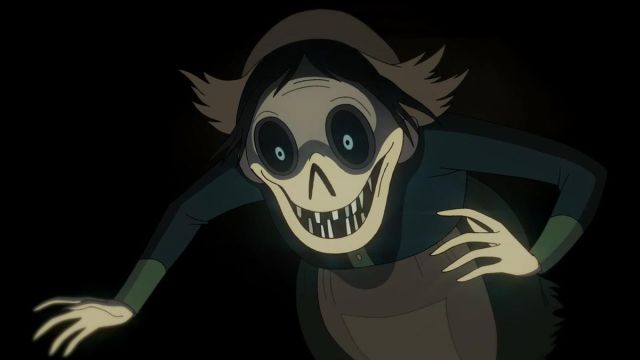‘Over the Garden Wall’ is Perfect Gateway Horror
Family entertainment and horror are two genres that don’t seem to mix. In the west we have an aversion to scaring children that makes creating horror work aimed at a younger audience difficult. Though this seems obvious and natural at first, it becomes ironic when you realize how much kids love horror.
Family entertainment has attempted to capitalize on this in a parent approved way for decades. Franchises like Scooby-Doo, the Addams Family, and Hotel Transylvania all use a horror aesthetic without attempting to scare their audience. Though children have responded well to franchises like this, they aren’t really attempting to frighten anyone.
On the opposite end of the spectrum is the Five Nights at Freddy’s video game series. These games were probably not originally made with children in mind, but whether intentional or not, this seems to be the series’ primary audience. It’s not as common anymore, but a few years ago you couldn’t enter an elementary school classroom without seeing a handful of Five Nights at Freddy’s themed backpacks and lunchboxes.
Though the Five Nights at Freddy’s series has earned its place in horror, there is little finesse or care put into its horror elements. Media like Freddy’s wants you to take its horror so seriously that, when you take a step back, all you can do is laugh.

If I had to pin down why, I would say it all feels insincere to me. This insincerity makes me appreciate genuinely scary children’s media more. Enter Cartoon Network’s 2014 miniseries, Over the Garden Wall. Though I don’t think most would initially classify the series as horror, it manages to be more unsettling than anything else I’ve seen that has been aimed at children.
The Unsettling Characters of The Uknown
Over the Garden Wall follows two brothers, older brother Wirt (Elijah Wood) and younger brother Greg (Collin Dean) as they attempt to find their way out of The Unknown, a forest teeming with strange creatures and even stranger people. Throughout their journey one thing that immediately jumps out about the series is how effortlessly its animation walks the line between creepy and family friendly. In episode two, Wirt and Greg stay in a village named Pottsfield where everyone wears harvest costumes. The most striking element of these costumes is the expressionless pumpkin heads worn by each villager. The lack of expression on the pumpkin heads instills a sense of unease in the characters and the viewers because you can’t immediately see or understand how they’re feeling.

Other examples include the wolf monster in episode one which looks like something straight out of Bloodborne or a werewolf movie, and the grotesquely oversized Auntie Whispers in episode seven.My favorite design though is the series’ main antagonist, the Beast. Much like every other classic horror movie monster, it’s what you don’t see about the Beast that is the most frightening. Except for one brief glimpse, the Beast is entirely obscured by shadows. Because the viewer is never able to see exactly what the Beast looks like, the show can let the viewer’s imagination fill in the blanks.
A trait shared by the people of Pottsfield, Auntie Whispers, and the Beast is a mostly monotone voice. Much like the earlier mentioned pumpkin heads, this makes these characters creepy because we can’t tell what they’re feeling. The Unknown functions similarly. It is a place that feels unstuck in time. Early twentieth century Americana mixes with the American frontier and every time period in between in the Unknown. The effect of this inability to pin down a time adds another layer of alienation to the show. Knowing when something takes place helps ground the reader/watcher and taking that away is disorienting. All these bewildering horror elements support the show’s main theme, that fear leads us to make bad decisions. Though Wirt and Greg do encounter a variety of monsters, it is Wirt’s fear that proves to be their biggest obstacle.

Fearing Fear Itself
In the penultimate episode, it is revealed that the show actually takes place in the present day. Wirt and Greg ended up in the Unknown after nearly being over by a train and then tumbling into a river, the implication being that the Unknown is a sort of purgatory. The only reason Wirt and Greg ended up in that situation is because Wirt wouldn’t admit he liked a girl. Wirt’s fear is evident in every aspect of his character, especially his relationship with his younger brother. For most of the series, Wirt refuses to take responsibility for protecting Greg because he is afraid.Afraid he’ll mess up. Afraid both of them will be hurt. Most of the characters in Over the Garden Wall make similarly bad decisions because they’re afraid. The Woodsman (Christopher Lloyd) Wirt and Greg meet in the first episode unwittingly keeps the Beast alive because he’s afraid of losing his daughter’s soul. The tea baron (John Cleese) in episode five is terrified of falling in love with his competitor and grows increasingly paranoid, believing that she is only a ghost he’s seen.
It’s this attention to thematic cohesion that sets Over the Garden Wall apart from other attempts at horror for a younger audience. Genuine and earnest aren’t usually words that enter the conversation surrounding horror, but good horror reflects a genuine fear. A personal fear.The horror presented by Over the Garden Wall shows that confronting our own flaws can be scarier than any monster. You can watch the short its based off of below or you can catch the whole series on Hulu.
